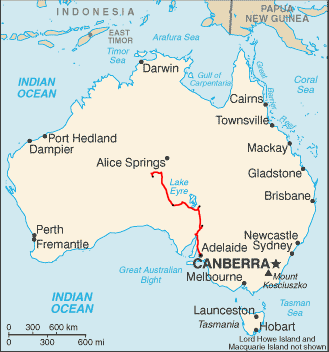 Photos!
Photos!
In the morning we got a tour of an opal mine by the owner of the campground in Coober Pedy. Like almost everyone else in the town, he spends part of his time mining for opal. He took us through an old opal mine, showed us how opal forms, how one goes about prospecting for it, staking a claim, and mining for it. He showed us the explosives they use for blasting and let us try divining rods, which apparently work for likely opal deposits as well as water. And they actually work! I never thought there was any science behind those things, but it turns out they really work. No pictures from this part, sorry.
We spent most of the day after that driving. Our destination for the night was a bush camp on the Mt. Conner cattle station. Cattle raising in Australia is profitable because many of the plants have very high protein levels, so cattle raised on them is healthier or tastier or something. Of course, at other times the cyanide levels in those same plants gets too high, killing the cattle that eat them. Not to mention all the other ways cattle can die in the outback. Cattle stations in the outback are usually enormous. The biggest Australian cattle station, Anna Creek, is six million acres - bigger than Belgium and four times as large as the biggest cattle ranch in the U.S.
At the bush camp we met our host, Ian, the owner of the cattle station. He was a very cool guy (must run with the name). He was the quintessential hardy outback type, friendly but soft spoken and a man of few words, knowledgeable and tough enough to enjoy living out where life is still very hard. Around the campfire he obliged us by telling us all about the different ways one could die in the outback. Besides the usual venomous snakes and spiders, other highlights included a type of wood that will give you gangrene within 12 hours from a splinter, and bullet ants, enormous (I mean enormous) ants with the most painful sting of any insect in the world. Oh good. His wife told us about the time a Common Brown Snake (euphemistically named, as it is horribly venomous) slithered into the outhouse she was using, and she had to sit there with the snake wrapped around her ankles until it decided to leave. They also told us about the various rescue operations they had been involved in, including a Checkoslovakian couple who were never found ("Yeah, they're still out there somewhere," chuckling) and a hiker Ian singlehandedly tracked and rescued ("I'm not sure he was all there in the head").
The next morning (okay, technically day five, but it fits better in here), Ian took us out on a walk to see the sun rise on Mount Conner, which was very pretty. He also showed us a lot of different plants and other features of the landscape (Ian: "This here is a bullet ant nest. They're all still inside the nest at this time of morning, but I'll poke it with this stick so some of them will come out." Everyone else: "Uhhh...."). You could tell from the way he talked that Ian truly enjoyed the land and his work.
Side note: For a good time, read about the Schmidt Pain Index for insect stings (on which bullet ants receive the highest rating). The descriptions are fantastic, and the story of the index's origin is pretty funny too. Entomologists are a strange breed.
1 comment:
Hi Ian,
Your travelogue is fascinating and the Schmidt Pain Index is hilarious in a sick kind of way. Stay away from those bullet ants!
Love, Mom
Post a Comment